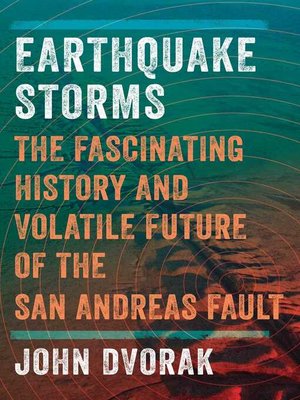Earthquake Storms
ebook ∣ The Fascinating History and Volatile Future of the San Andreas Fault
By John Dvorak

Sign up to save your library
With an OverDrive account, you can save your favorite libraries for at-a-glance information about availability. Find out more about OverDrive accounts.
Find this title in Libby, the library reading app by OverDrive.



Search for a digital library with this title
Title found at these libraries:
| Library Name | Distance |
|---|---|
| Loading... |
"Dvorak has done earthquake science sterling service by writing what is unarguably the best, the most comprehensive and compellingly readable book about the great fault, America's 800 mile long seismic danger zone, that will one day affect all of our lives."—Simon Winchester, New York Times Bestselling author of The Crack at the Edge of the World and Krakatoa
It is a prominent geological feature that is almost impossible to see unless you know where to look. Hundreds of thousands of people drive across it every day. The San Andreas Fault is everywhere, and primed for a colossal quake. For decades, scientists have warned that such a sudden shifting of the Earth's crust is inevitable. In fact, it is a geologic necessity.The San Andreas fault runs almost the entire length of California, from the redwood forest to the east edge of the Salton Sea. Along the way, it passes through two of the largest urban areas of the country - San Francisco and Los Angeles. Dozens of major highways and interstates cross it. Scores of housing developments have been planted over it. The words "San Andreas" are so familiar today that they have become synonymous with earthquake.Yet, few people understand the San Andreas or the network of subsidiary faults it has spawned. Some run through Hollywood, others through Beverly Hills and Santa Monica. The Hayward fault slices the football stadium at the University of California in half. Even among scientists, few appreciate that the San Andreas fault is a transient, evolving system that, as seen today, is younger than the Grand Canyon and key to our understanding of earthquakes worldwide.
It is a prominent geological feature that is almost impossible to see unless you know where to look. Hundreds of thousands of people drive across it every day. The San Andreas Fault is everywhere, and primed for a colossal quake. For decades, scientists have warned that such a sudden shifting of the Earth's crust is inevitable. In fact, it is a geologic necessity.The San Andreas fault runs almost the entire length of California, from the redwood forest to the east edge of the Salton Sea. Along the way, it passes through two of the largest urban areas of the country - San Francisco and Los Angeles. Dozens of major highways and interstates cross it. Scores of housing developments have been planted over it. The words "San Andreas" are so familiar today that they have become synonymous with earthquake.Yet, few people understand the San Andreas or the network of subsidiary faults it has spawned. Some run through Hollywood, others through Beverly Hills and Santa Monica. The Hayward fault slices the football stadium at the University of California in half. Even among scientists, few appreciate that the San Andreas fault is a transient, evolving system that, as seen today, is younger than the Grand Canyon and key to our understanding of earthquakes worldwide.







